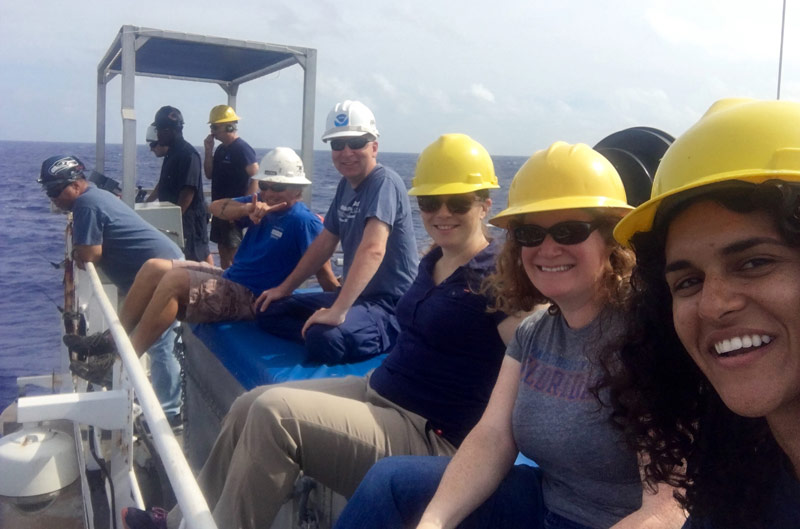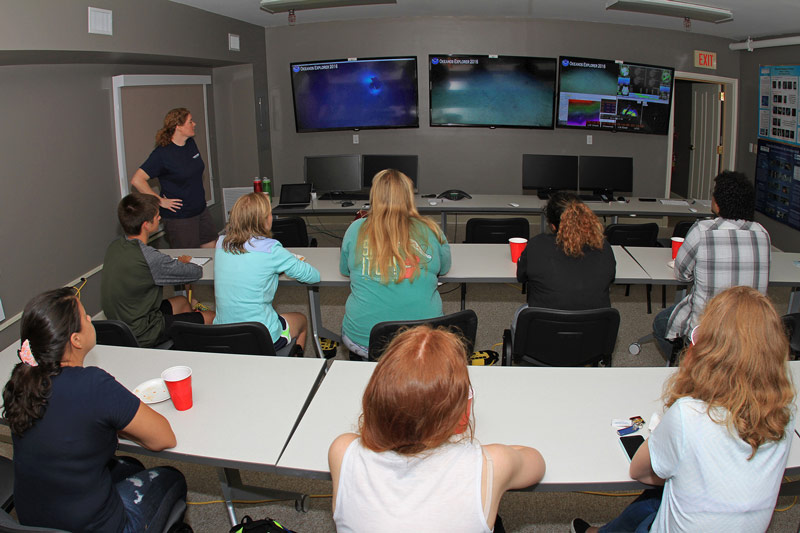
By Deb Glickson, Associate Director, NOAA Cooperative Institute for Ocean Exploration, Research, and Technology
August 11, 2016

Deb and the rest of the expedition science team watch a remotely operated vehicle recovery during the Deepwater Exploration of the Marianas Expedition. Image courtesy of NOAA Office of Ocean Exploration and Research, 2016 Deepwater Exploration of the Marianas. Download larger version (jpg, 1.4 MB).
Life on board a ship has its advantages and disadvantages. For example:
Obviously, one huge advantage is that you are immersed in the world of exploration. As the Leg 1 Geology Lead of the Deepwater Exploration of the Marianas expedition on board the Okeanos Explorer, my whole day revolved around our dives—conducting the pre-dive call with shore-based scientists; executing and narrating the dive with Diva Amon, the Leg 1 Biology Lead and my “partner in crime;” dealing with unexpected difficulties with the weather, the ship, remotely operated vehicles, or communications; preparing the next day’s dive plans; and summarizing the initial results of the dive.
While this was going on, I’d run down the hall to my bunk to grab a notebook or a sweatshirt, or run to the galley for tea, or step out onto the back deck for a bit of fresh air, or zip into the dry lab for a break from sitting in the dark control room. However, I’d always be within shouting or running distance of the dive, ready to head back in if needed.
Even though life on the ship was busy, it was easy to leave work behind and immerse myself in ocean exploration 24 hours a day, seven days a week. Of course, this wouldn’t have been possible without people like my awesome boss, Cooperative Institute for Ocean Exploration, Research, and Technology Executive Director Shirley Pomponi (who also happened to be the Leg 3 Biology Lead), who made sure that my day job didn’t interfere with being at sea, and my parents, who watched my dog for an entire month (she’s really sorry about eating all the doughnuts).
So, how does it compare to be a shore-based scientist? I had the opportunity to find out as a shore-based participant on Leg 3. To be honest, it’s much harder to be a shore-based scientist, and I cannot give enough credit to the awesome team of scientists that often volunteer their days, evenings, nights, and weekends (depending on where in the world they are) because they love exploring with the NOAA Office of Ocean Exploration and Research and the Okeanos Explorer. For those of us in faraway time zones, the dives began in the evening (U.S. East Coast), the middle of the night (Russia), or super-early morning (Japan).
Because the ship was about 14 hours ahead of my time zone, I had to make some serious adjustments to my daily schedule. On a typical day, I woke up around 10 am (ET), ran errands, and did those annoying-but-essential life activities (laundry, grocery shopping, etc.), through the early afternoon. During this time, I also had to keep up with all the tasks related to my day job – emails, phone calls, and the like. At about 4-5 pm, I headed into the Harbor Branch Oceanographic Institution (HBOI) Exploration Command Center (ECC) for the pre-dive call. I left between 11 pm and 1 am, drove home, took the dog for super-late-night walks, and finished the day pretty exhausted.

Deb working with interns at the Harbor Branch Exploration Command Center. Image courtesy of the NOAA Office of Ocean Exploration and Research, Deepwater Wonders of Wake. Download larger version (jpg, 1.7 MB).
Even though it is much harder to balance the daily activities of life as a shore-based scientist, it is also more flexible. If you need to take a day off, you can! And you can directly engage others in exploration, which is awesome. For example, HBOI interns came to the ECC during Leg 3 to learn about telepresence, which led to several repeat visits. I was also able to participate in one dive while with friends on a trip to Washington, DC—they enjoyed a glimpse “behind the scenes,” such as the explanation of how the scientist chatroom (EventLog) is used.
Another advantage to the shore-based scientist? Not getting seasick, especially enjoyable when the ship is outrunning a typhoon (sorry, Wonders of Wake people!).
So, what’s the verdict—ship-based or shore-based? The answer is pretty obvious. Either! I’m just glad to have be included in such fascinating expeditions and to work with wonderful ship crew, mission specialists, and other scientists.